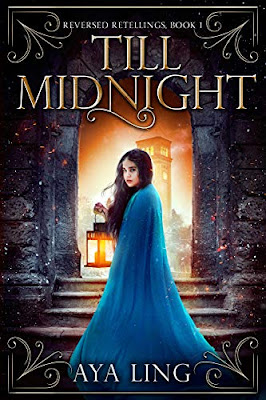Review: Till Midnight
Since I was completely enamored with Aya Ling's Unfinished Fairy Tales books, I was thrilled to learn that she would be launching a new series of fairy tale adaptations. She has quickly raised in the ranks to become one of my favorite authors. Her new Reversed Retellings books portray gender-swapped versions of classic fairy tales, presenting brand new perspectives and challenging outdated gender stereotypes. The first book in the series is Till Midnight, based on the story of "The Twelve Dancing Princesses." However, this version has twelve handsome princes who are forced to sneak away at night due to a curse with a female cobbler who must solve the mystery of where they go. I absolutely loved this adaptation and cannot wait for her to release more gender-swapped fairy tales.
Till Midnight tells the story of Alix, a talented young lady working as a dressmaker's apprentice in an attempt to further her career beyond the family trade of cobbling shoes. Even though it is set in medieval times, Alix is an independent modern-day woman with strong ambitions and a kind heart. She is very focused on improving her value as an employee so that she can make more money to care for her sickly aunt. The book references a lot of real-life problems you don't normally see in princess stories, such as struggling to make rent and aspiring toward job promotions. Fortunately, there's plenty of fantasy to balance out the reality. Since this book challenges common gender stereotypes, it's only fitting that Alix has a gay best friend. Fabio works with her at the dressmaker shop and is pressured by his parents to marry a woman when he is only interested in men. Therefore, it's a dream come true when he and Alix are recruited to work at the castle with twelve strapping princes. Though his portrayal as a gay man in fashion is somewhat stereotypical, his exuberant nature is the perfect balance to Alix's seriousness toward her work and responsibilities.
Every novel adaptation I've read of "The Twelve Dancing Princesses" turns the secret late night dancing sessions into a curse that the twelve young royals cannot escape. This version was no different. As much I would love to read an adaptation where the princesses actually want to escape to their magical land of silver trees like in the Barbie movie and the original fairy tale, I still have to commend Aya Ling on her creative interpretation for Till Midnight. For most of the novel, it is just as much of a mystery to the reader as it is to Alix why the twelve princes disappear at night and return with gruesome injuries and torn up boots. When she finally does discover the cause, it is far more fitting for the gender reversal than dancing in ballgowns would have been. Just as other adaptations portray the princesses being forced do something against their will that women are stereotypically expected to enjoy, this portrays the princes being forced to do something that men are stereotypically expected to enjoy, which I found to be a clever twist.
The biggest challenge with this fairy tale is assigning distinctive enough personalities to all twelve princesses to make it possible to keep track of all of them. Shelley Duval's Faerie Tale Theatre series from the 1980s took a shortcut with this by changing their number for twelve to six. In Till Midnight, there are indeed twelve princes, but only about five of them are distinctive enough to be memorable. Theo, the oldest prince, has a reputation for being cold and distant, especially toward women, but that changes when Alix manages to worm her way into his heart through her compassion and understanding. The twins, Ethan and Enzo, are the most entertaining characters in the book. It is very funny to see them attempt to flirt with Alix when it is clear that they have no experience talking to women. Alix's confused reactions are equally amusing, as she is very serious by nature and not at all flirtatious. Roland, the youngest prince, is the emotional heart of the story. The danger that the curse wrought upon him is the final straw in motivating all the characters to break it. Gerald, the handsome scholar, is revealed become the "beauty" character in the next Reversed Retelling book, which will be based on "Beauty and the Beast."
There are so many things I loved about Till Midnight. It takes modern princess culture and incorporates it into a classic fairy tale setting. I loved that despite all the changes, Aya Ling didn't stray too far from the original story. It proves that it's completely possible to modernize a fairy tale without ripping it apart at its seams the way Frozen did. Even though I wished Fabio was a bit less of a stereotype, I loved how his flamboyance played off Alix's seriousness. As a Millenial, I found it easy to relate to Alix's struggles of advancing her career and making enough money to pay her aunt's rent. I highly recommend this book to anyone who enjoys contemporary fairy tales, and I can't wait to read the next one!
Till Midnight tells the story of Alix, a talented young lady working as a dressmaker's apprentice in an attempt to further her career beyond the family trade of cobbling shoes. Even though it is set in medieval times, Alix is an independent modern-day woman with strong ambitions and a kind heart. She is very focused on improving her value as an employee so that she can make more money to care for her sickly aunt. The book references a lot of real-life problems you don't normally see in princess stories, such as struggling to make rent and aspiring toward job promotions. Fortunately, there's plenty of fantasy to balance out the reality. Since this book challenges common gender stereotypes, it's only fitting that Alix has a gay best friend. Fabio works with her at the dressmaker shop and is pressured by his parents to marry a woman when he is only interested in men. Therefore, it's a dream come true when he and Alix are recruited to work at the castle with twelve strapping princes. Though his portrayal as a gay man in fashion is somewhat stereotypical, his exuberant nature is the perfect balance to Alix's seriousness toward her work and responsibilities.
Every novel adaptation I've read of "The Twelve Dancing Princesses" turns the secret late night dancing sessions into a curse that the twelve young royals cannot escape. This version was no different. As much I would love to read an adaptation where the princesses actually want to escape to their magical land of silver trees like in the Barbie movie and the original fairy tale, I still have to commend Aya Ling on her creative interpretation for Till Midnight. For most of the novel, it is just as much of a mystery to the reader as it is to Alix why the twelve princes disappear at night and return with gruesome injuries and torn up boots. When she finally does discover the cause, it is far more fitting for the gender reversal than dancing in ballgowns would have been. Just as other adaptations portray the princesses being forced do something against their will that women are stereotypically expected to enjoy, this portrays the princes being forced to do something that men are stereotypically expected to enjoy, which I found to be a clever twist.
The biggest challenge with this fairy tale is assigning distinctive enough personalities to all twelve princesses to make it possible to keep track of all of them. Shelley Duval's Faerie Tale Theatre series from the 1980s took a shortcut with this by changing their number for twelve to six. In Till Midnight, there are indeed twelve princes, but only about five of them are distinctive enough to be memorable. Theo, the oldest prince, has a reputation for being cold and distant, especially toward women, but that changes when Alix manages to worm her way into his heart through her compassion and understanding. The twins, Ethan and Enzo, are the most entertaining characters in the book. It is very funny to see them attempt to flirt with Alix when it is clear that they have no experience talking to women. Alix's confused reactions are equally amusing, as she is very serious by nature and not at all flirtatious. Roland, the youngest prince, is the emotional heart of the story. The danger that the curse wrought upon him is the final straw in motivating all the characters to break it. Gerald, the handsome scholar, is revealed become the "beauty" character in the next Reversed Retelling book, which will be based on "Beauty and the Beast."
There are so many things I loved about Till Midnight. It takes modern princess culture and incorporates it into a classic fairy tale setting. I loved that despite all the changes, Aya Ling didn't stray too far from the original story. It proves that it's completely possible to modernize a fairy tale without ripping it apart at its seams the way Frozen did. Even though I wished Fabio was a bit less of a stereotype, I loved how his flamboyance played off Alix's seriousness. As a Millenial, I found it easy to relate to Alix's struggles of advancing her career and making enough money to pay her aunt's rent. I highly recommend this book to anyone who enjoys contemporary fairy tales, and I can't wait to read the next one!












Comments